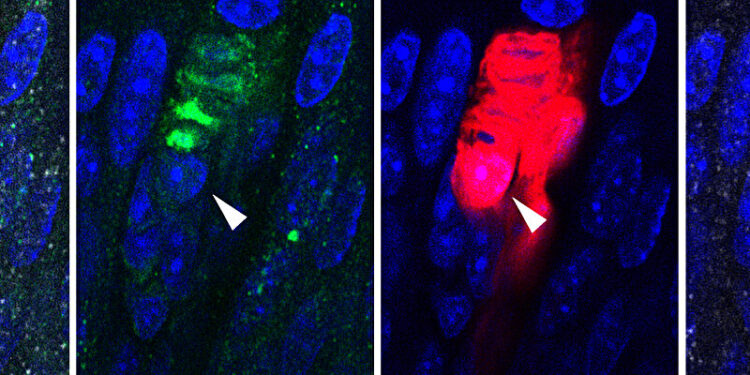SOX10-positive Schwann sensory cells shown in red, sensory ending in the Meissner corpuscle in green, SOX2-positive cell at the base of the Meissner corpuscle shown in silver. Credit: Lewin Lab, Max Delbrück Center
Special receptor cells under the skin allow us to feel pain and touch. But Schwann cells also play a key role in detecting such stimuli, researchers from the Max Delbrück Center report in Natural communications. This discovery opens new avenues for the treatment of pain.
The skin contains numerous sensory receptor endings that detect touch, heat and cold, but also potential dangers such as harmful mechanical and chemical stimuli. These sensory cells then send a corresponding signal to the spinal cord and brain. Scientists previously thought that only sensory neurons were responsible for this task. However, it turns out that Schwann cells also play an essential role, as now reported by the groups of Professor Gary Lewin and Professor James Poulet at the Max Delbrück Center, as well as an international research team.
Schwann cells are known to act as an insulating layer around nerve fibers. They protect and provide nutrients to neurons. Yet new research has shown that specific types of Schwann cells are also actively involved in detecting sensory stimuli. These Schwann cells form a network-like structure a few micrometers below the epidermis and are connected to the free nerve endings of sensory receptors that detect mechanical pressure.
“We were surprised to see the extent to which Schwann cells participate in the detection of stimuli,” explains Gary Lewin, head of the laboratory for molecular physiology of somatic sensations at the Max Delbrück Center.
The first indications of the importance of Schwann cells in pain perception (nociception) came from earlier studies by Lewin’s Swedish collaborators.
This prompted Julia Ojeda-Alonso from the Lewin Lab and the Poulet Lab to team up with international colleagues like Dr. Laura Calvo-Enrique from the Karolinska Institutet in Stockholm to get to the bottom of this. Using a technique called optogenetics, the researchers bred mice in which they were able to turn different types of Schwann cells on and off with different colors of light.
Without Schwann cells, mice couldn’t feel the vibrations
To transmit painful sensations to the brain, it was enough to activate the Schwann cells with a light stimulus. It was not necessary to stimulate the nociceptors themselves. When Schwann cells were blocked, the transmission of stimuli by nociceptors was reduced by at least half. “We speculate that technical limitations have prevented us from fully mapping the role of Schwann cells and that, in some cases, they actually do most of the stimulus detection,” says Lewin.
The team then conducted experiments with tactile stimuli. They focused on Meissner corpuscles, which are vibration receptors in the skin closely associated with Schwann cells. The team led by James Poulet, who heads the Neural Circuits and Behavior Laboratory at the Max Delbrück Center, trained the mice to detect tiny vibrations with their forepaw and report detection of these stimuli.
“When the Schwann cells were turned off, it was much more difficult for the mice,” says Poulet. Once the optogenetic blockade was removed, their ability to detect tiny skin vibrations returned.
New approaches to pain treatment
The researchers showed that Schwann cells mainly influence the transmission of mechanical stimuli, but not thermal or cold stimuli. “It may be that polymodal nociceptors, which respond to mechanical, thermal and chemical stimuli, only function properly with the help of Schwann cells,” says Lewin.
The results open new avenues for understanding and treating pain and altered perception of touch. “Schwann cells located just below the surface of the skin are easily accessible to therapeutic agents,” says Lewin. “This makes it an attractive target to attack the problem at the root.”
More information:
Julia Ojeda-Alonso et al, Schwann sensory cells set perceptual thresholds for touch and selectively regulate mechanical nociception, Natural communications (2024). DOI: 10.1038/s41467-024-44845-8
Provided by the Max Delbrück Center for Molecular Medicine
Quote: Study finds Schwann cells play essential role in pain and tactile sensations (February 6, 2024) retrieved February 6, 2024 from
This document is subject to copyright. Apart from fair use for private study or research purposes, no part may be reproduced without written permission. The content is provided for information only.



